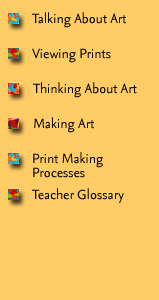
 |
||||||||
|
|
||||||||
|
|
|
|
|
|
|
|
|
|
|
|
||||||||

|
|
Home > Learning
Resources > Teacher's Packet
> Print Making
Processes > Relief ProcessesRelief ProcessesIn relief printing processes, the original flat surface to be cut is the printing surface. Parts of the design not to be printed are removed or cut away. The remaining raised image is then inked with a brayer, and then printed onto paper. Because printing presses are not needed, these printing processes are usually considered easier than others, and can require less studio space, and less equipment. The three Relief processes are: Linocut or Linoleum Cut Linoleum cut printing is one of the easiest techniques to learn for the beginning printmaker. Both monochrome and multicolor prints can be created. The artist uses metal tools to remove areas from a sheet of linoleum, and due to the uniform nature of the material, cuts in any direction are easy to make. Multicolored design can be created in one of two ways. One way is the reduction method, in which more of the linoleum is removed in stages for the different colors of ink to be applied. The other, perhaps more difficult method involves the carving of separate pieces of linoleum for each color. The alignment of the various layers of color is easier in the reductive method, but the process destroys the previous layers, effectively limiting the number of editions that can be printed of the image. Woodblock Print Woodblock prints are made from a plate created by cutting into side grain pieces of wood. Usually the designs take into account the grain of the wood, as it is usually easier to cut with the grain than against it. As in Linocut printing, the areas to remain the color of the paper are removed, and the areas to be printed in a color remain and are inked with a brayer. Ukiyo-e Ukiyo-e
is a Japanese woodcut technique. It translates to “pictures of the floating
world.” It has been around since the Edo period of Japan (1603-1867).
Originally, the images were monochromatic, but throughout the 18th
and 19th centuries, innovations in technique allowed them to
create more complex multicolor prints. Traditionally, one person chooses the
color separations, draws onto the blocks, and prints them, while a second
person is responsible for all of the carving. In the case of Emma,
Close contracted the master printer Yasu Shinbata, a master at drawing,
painting, and carving, to do all of the printmaking himself, using a
painting by Close as a guide. |